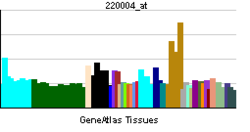- DDX43
-
DEAD (Asp-Glu-Ala-Asp) box polypeptide 43 Identifiers Symbols DDX43; CT13; DKFZp434H2114; HAGE External IDs OMIM: 606286 HomoloGene: 56814 GeneCards: DDX43 Gene EC number 3.6.4.13 Gene Ontology Molecular function • nucleotide binding
• RNA binding
• ATP-dependent RNA helicase activity
• helicase activity
• ATP binding
• hydrolase activityCellular component • intracellular Sources: Amigo / QuickGO RNA expression pattern 
More reference expression data Orthologs Species Human Mouse Entrez 55510 100048658 Ensembl ENSG00000080007 ENSMUSG00000070291 UniProt Q9NXZ2 n/a RefSeq (mRNA) NM_018665 n/a RefSeq (protein) NP_061135 n/a Location (UCSC) Chr 6:
74.1 – 74.13 MbChr 9:
78.24 – 78.27 MbPubMed search [1] [2] Probable ATP-dependent RNA helicase DDX43 is an enzyme that in humans is encoded by the DDX43 gene.[1][2]
The protein encoded by this gene is an ATP-dependent RNA helicase in the DEAD-box family and displays tumor-specific expression.[2]
References
- ^ Martelange V, De Smet C, De Plaen E, Lurquin C, Boon T (Aug 2000). "Identification on a human sarcoma of two new genes with tumor-specific expression". Cancer Res 60 (14): 3848–55. PMID 10919659.
- ^ a b "Entrez Gene: DDX43 DEAD (Asp-Glu-Ala-Asp) box polypeptide 43". http://www.ncbi.nlm.nih.gov/sites/entrez?Db=gene&Cmd=ShowDetailView&TermToSearch=55510.
Further reading
- Hartley JL, Temple GF, Brasch MA (2001). "DNA cloning using in vitro site-specific recombination". Genome Res. 10 (11): 1788–95. doi:10.1101/gr.143000. PMC 310948. PMID 11076863. http://www.pubmedcentral.nih.gov/articlerender.fcgi?tool=pmcentrez&artid=310948.
- Wiemann S, Weil B, Wellenreuther R, (2001). "Toward a catalog of human genes and proteins: sequencing and analysis of 500 novel complete protein coding human cDNAs". Genome Res. 11 (3): 422–35. doi:10.1101/gr.GR1547R. PMC 311072. PMID 11230166. http://www.pubmedcentral.nih.gov/articlerender.fcgi?tool=pmcentrez&artid=311072.
- Simpson JC, Wellenreuther R, Poustka A, (2001). "Systematic subcellular localization of novel proteins identified by large-scale cDNA sequencing". EMBO Rep. 1 (3): 287–92. doi:10.1093/embo-reports/kvd058. PMC 1083732. PMID 11256614. http://www.pubmedcentral.nih.gov/articlerender.fcgi?tool=pmcentrez&artid=1083732.
- Strausberg RL, Feingold EA, Grouse LH, (2003). "Generation and initial analysis of more than 15,000 full-length human and mouse cDNA sequences". Proc. Natl. Acad. Sci. U.S.A. 99 (26): 16899–903. doi:10.1073/pnas.242603899. PMC 139241. PMID 12477932. http://www.pubmedcentral.nih.gov/articlerender.fcgi?tool=pmcentrez&artid=139241.
- Nagel H, Laskawi R, Eiffert H, Schlott T (2003). "Analysis of the tumour suppressor genes, FHIT and WT-1, and the tumour rejection genes, BAGE, GAGE-1/2, HAGE, MAGE-1, and MAGE-3, in benign and malignant neoplasms of the salivary glands". MP, Mol. Pathol. 56 (4): 226–31. doi:10.1136/mp.56.4.226. PMC 1187325. PMID 12890744. http://www.pubmedcentral.nih.gov/articlerender.fcgi?tool=pmcentrez&artid=1187325.
- Gerhard DS, Wagner L, Feingold EA, (2004). "The status, quality, and expansion of the NIH full-length cDNA project: the Mammalian Gene Collection (MGC)". Genome Res. 14 (10B): 2121–7. doi:10.1101/gr.2596504. PMC 528928. PMID 15489334. http://www.pubmedcentral.nih.gov/articlerender.fcgi?tool=pmcentrez&artid=528928.
- Wiemann S, Arlt D, Huber W, (2004). "From ORFeome to biology: a functional genomics pipeline". Genome Res. 14 (10B): 2136–44. doi:10.1101/gr.2576704. PMC 528930. PMID 15489336. http://www.pubmedcentral.nih.gov/articlerender.fcgi?tool=pmcentrez&artid=528930.
- Mehrle A, Rosenfelder H, Schupp I, (2006). "The LIFEdb database in 2006". Nucleic Acids Res. 34 (Database issue): D415–8. doi:10.1093/nar/gkj139. PMC 1347501. PMID 16381901. http://www.pubmedcentral.nih.gov/articlerender.fcgi?tool=pmcentrez&artid=1347501.
- Roman-Gomez J, Jimenez-Velasco A, Agirre X, (2007). "Epigenetic regulation of human cancer/testis antigen gene, HAGE, in chronic myeloid leukemia". Haematologica 92 (2): 153–62. doi:10.3324/haematol.10782. PMID 17296563.
- Mathieu MG, Knights AJ, Pawelec G, (2007). "HAGE, a cancer/testis antigen with potential for melanoma immunotherapy: identification of several MHC class I/II HAGE-derived immunogenic peptides". Cancer Immunol. Immunother. 56 (12): 1885–95. doi:10.1007/s00262-007-0331-2. PMID 17487488.
Categories:- Human proteins
- Chromosome 6 gene stubs
Wikimedia Foundation. 2010.
